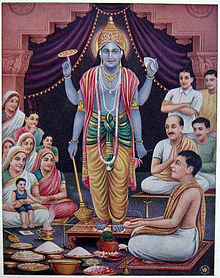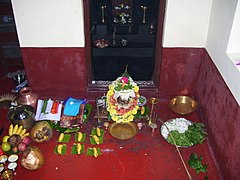
Kurma, is the second avatar of the Hindu preserver deity, Vishnu. Originating in Vedic literature such as the Yajurveda as being synonymous with the Saptarishi called Kashyapa, Kurma is most commonly associated in post-Vedic literature such as the Puranas. He prominently appears in the legend of the churning of the Ocean of Milk, referred to as the Samudra Manthana. Along with being synonymous with Akupara, the World-Turtle supporting the Earth, Kurma is listed as the second of the Dashavatara, which are the ten principal incarnations of Vishnu.
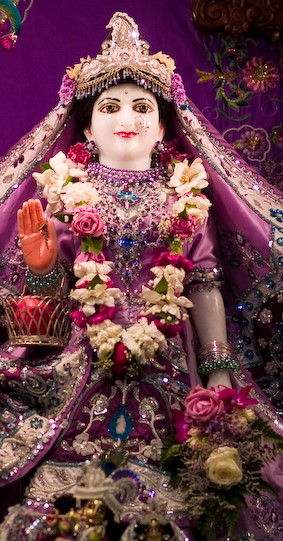
Rukmini is a Hindu goddess and the first queen of Krishna in Dvaraka. In Vaishnava tradition, she is described as Krishna's principal queen in Dvaraka, as well as the chief of his wives. She is an incarnation of the goddess of prosperity, Lakshmi. The goddess is regarded to be the chief or principal consort of Krishna in various pieces of literature and is venerated primarily in Warkari and Haridasa tradition, and additionally in Sri Vaishnavism where Lakshmi-Narayana are revered and worshipped.

The Vishnu Sahasranama, is a Sanskrit hymn containing a list of the 1,000 names of Vishnu, one of the main deities in Hinduism and the Supreme God in Vaishnavism. It is one of the most sacred and popular stotras in Hinduism. The most popular version of the Vishnu Sahasranama is featured in the Anushasana Parva of the epic Mahabharata. Other versions exist in the Padma Purana, the Skanda Purana, and the Garuda Purana. There is also a Sikh version of the Vishnu Sahasranama found in the work Sundar Gutka.
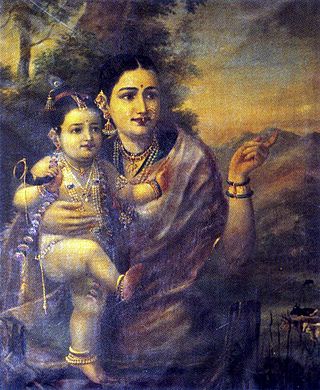
Krishna Janmashtami, also known simply as Krishnashtami,Janmashtami, or Gokulashtami, is an annual Hindu festival that celebrates the birth of Krishna, the eighth avatar of Vishnu. In certain Hindu texts, such as the Gita Govinda, Krishna has been identified as supreme God and the source of all avatars. Krishna's birth is celebrated and observed on the eighth day (Ashtami) of the dark fortnight in Shravana Masa or Bhadrapada Masa. This overlaps with August or September of the Gregorian calendar.
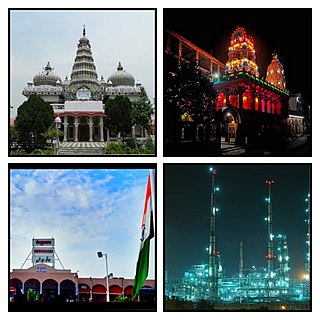
Begusarai is the industrial and financial capital of Bihar and the administrative headquarters of the Begusarai district, which is one of the 38 districts of the Indian state of Bihar. The district lies on the northern bank of the river Ganges in the Mithila region of India.
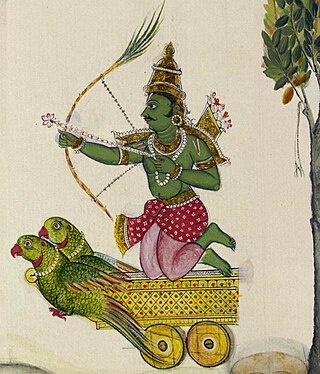
Kama, also known as Kamadeva and Manmatha, is the Hindu god of erotic love, desire, and pleasure, often portrayed alongside his consort and female counterpart, Rati. He is depicted as a handsome young man decked with ornaments and flowers, armed with a bow of sugarcane and shooting arrows of flowers.
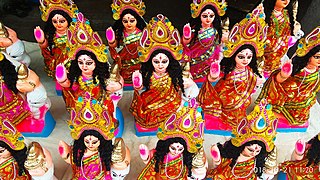
Sharad Purnima is a religious festival celebrated on the full moon day of the Hindu lunar month of Ashvin, marking the end of the monsoon season. The full moon night is celebrated in different ways in various cultural regions across Indian subcontinent.

Koodalmanikyam Temple is a Hindu temple in Irinjalakuda Municipality, Thrissur district, Kerala, India. The temple comprises a main structure, a walled compound with citadels, and four ponds around the main structure one of which is within the walls. Koodalmanikyam Temple is the only ancient temple in India dedicated to the worship of Bharata, the second brother of Rama, however the idol is that of god Vishnu. "Sangameshwara" is another name associated with the deity at Koodalmanikyam. The temple is one of four in Kerala that form a set called "nalambalam", each temple dedicated to one of the four brothers in the epic Ramayana: Rama, Bharata, Lakshmana and Shatrughna.

A shaligram, or shaligrama shila, is a fossilized stone or ammonite collected from the riverbed or banks of the Kali Gandaki, a tributary of the Gandaki River in Nepal. It is also considered a form of Vishnu within Hinduism.

Shiva Puja in Hinduism is the way by which one worships Shiva through traditional and ancient rites with the use of mantra, tantra, yantra, kriyas, mudras, and abhishekam.

Badarinath or Badarinarayana Temple is a Hindu temple dedicated to Vishnu. It is situated in the town of Badrinath in Uttarakhand, India. The temple is also one of the 108 Divya Desams dedicated to Vishnu—holy shrines for Vaishnavas—who is worshipped as Badrinath. It is open for six months every year, because of extreme weather conditions in the Himalayan region. The temple is located in Garhwal hill tracks in Chamoli district along the banks of Alaknanda River. It is one of the most visited pilgrimage centers of India, having recorded 2.8 million visits in just 2 months in 2022. It is one of the Char Dham pilgrimage sites.

Panjiri is a Ayurvedic sweet dish from the Indian subcontinent which is specially prepared for Krishna Janmashtami festival. The sweet panjiri evolved from an Ayurvedic preparation called Panchajīraka.

Annapurna, Annapurneshwari, Annada or Annapoorna is a manifestation of Parvati and is known as the Hindu goddess of food and nourishment. Worship and offering of food are highly praised in Hinduism, and therefore, the goddess Annapurna is regarded as a popular deity. She is a manifestation of the goddess Parvati, the wife of Shiva, and is eulogized in the Annada Mangal, a narrative poem in Bengali by Bharatchandra Ray. The Annapurna Sahasranam is dedicated to the goddess and praises her one thousand names, while the Annapurna Shatanama Stotram is dedicated to her 108 names.

Tulasi Vivaha, also called Tulasi Kalyanam, is a Hindu festival, in which a symbolic ceremonial wedding takes place between a tulasi plant or holy basil and a shaligrama or an amla branch. Tulasi Vivaha signifies the end of the monsoon, and the beginning of the wedding season in Hinduism.
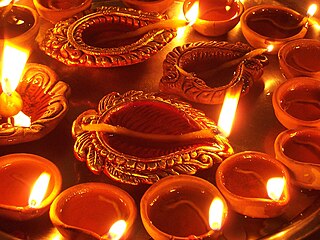
Worship in Hinduism is an act of religious devotion usually directed to one or more Hindu deities, invoking a sense of Bhakti or devotional love. This term is probably a central one in Hinduism, but a direct translation from the Sanskrit to English is difficult. Worship in Hinduism takes many forms, and its expression vary depending on geographical, linguistic, and cultural factors. Hindu worship is not limited to a particular place and Hindus perform worship in temples and within the home. It often incorporates personal reflection, music, dance, poetry, rituals, and ceremonies. Worship in Hinduism serves various purposes, including seeking blessings, guidance, or specific outcomes, as well as fostering a sense of inner peace and spiritual growth. It can also be an expression of devotion (bhakti) to the deity. The aim is to lead a pure life in order to progress spiritually and eventually attain liberation (moksha) from the cycle of rebirth.
Jaya Parvati Vrat or Gauri Vrat, is a Hindu festival observed in the month of Ashadha whereby unmarried women fast for five days and worship the Hindu goddess Parvati in order to seek an ideal husband. Foods containing salt are not eaten; instead, items such as wheat flour, milk, ghee and fruits are consumed. The festival is observed mainly in the state of Gujarat.

Mahaprasad is the term applied to the 56 food items offered to Lord Jagannath in the holy Temple of Puri, located in Odisha, India. The Bhog/Naivedya offered to him and later to Maa Bimala in the Grand Temple and remains of that Nivedana is known as ‘Mahaprasad’. Mahaprasad is also widely named as the famous Chappan Bhog.

Nirjala Ekadashi is a Hindu holy day falling on the 11th lunar day (ekadashi) of the waxing fortnight of the Hindu month of Jyeshtha (May/June). This ekadashi derives its name from the water-less (Nir-jala) fast observed on this day. It is considered to be the most austere and hence the most sacred of all 24 ekadashis. If observed religiously, it is said to be the most rewarding and granting the virtue gained by the observance of all 24 ekadashis in the year.
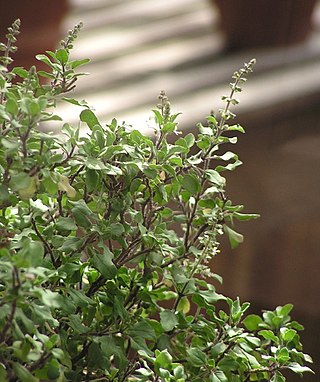
Tulasi, or Vrinda is a sacred plant in Hindu tradition. Hindus regard it as an earthly manifestation of the goddess Tulasi; she is regarded as the avatar of Lakshmi, and thus the consort of the god Vishnu. In another iteration, as Vrinda, she is married to Jalandhara. The offering of its leaves is recommended in ritualistic worship of Vishnu and his avatars, like Krishna and Vithoba.

Vaikuntha Chaturdashi is a Hindu holy day, which is observed on chaturdashi, the 14th lunar day of the waxing moon fortnight of the Hindu month of Kartika (November–December). The day is sacred to the deities Vishnu and Shiva. They are worshipped individually or together in different temples in Varanasi, Rishikesh, Gaya, and Maharashtra.
